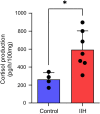Increased systemic and adipose 11β-HSD1 activity in idiopathic intracranial hypertension
- PMID: 35584002
- PMCID: PMC9346265
- DOI: 10.1530/EJE-22-0108
Increased systemic and adipose 11β-HSD1 activity in idiopathic intracranial hypertension
Abstract
Context: Idiopathic intracranial hypertension (IIH) is a disease of raised intracranial pressure (ICP) of unknown etiology. Reductions in glucocorticoid metabolism are associated with improvements in IIH disease activity. The basal IIH glucocorticoid metabolism is yet to be assessed.
Objective: The objective of this study was to determine the basal glucocorticoid phenotype in IIH and assess the effects of weight loss on the IIH glucocorticoid phenotype.
Design: A retrospective case-control study and a separate exploratory analysis of a prospective randomized intervention study were carried out.
Methods: The case-control study compared female IIH patients to BMI, age, and sex-matched controls. In the randomized intervention study, different IIH patients were randomized to either a community weight management intervention or bariatric surgery, with patients assessed at baseline and 12 months. Glucocorticoid levels were determined utilizing 24-h urinary steroid profiles alongside the measurement of adipose tissue 11β-HSD1 activity.
Results: Compared to control subjects, patients with active IIH had increased systemic 11β-hydroxysteroid dehydrogenase (11β-HSD1) and 5α-reductase activity. The intervention study demonstrated that weight loss following bariatric surgery reduced systemic 11β-HSD1 and 5α-reductase activity. Reductions in these were associated with reduced ICP. Subcutaneous adipose tissue explants demonstrated elevated 11β-HSD1 activity compared to samples from matched controls.
Conclusion: The study demonstrates that in IIH, there is a phenotype of elevated systemic and adipose 11β-HSD1 activity in excess to that mediated by obesity. Bariatric surgery to induce weight loss was associated with reductions in 11β-HSD1 activity and decreased ICP. These data reflect new insights into the IIH phenotype and further point toward metabolic dysregulation as a feature of IIH.
Figures



References
-
- Mollan SP, Davies B, Silver NC, Shaw S, Mallucci CL, Wakerley BR, Krishnan A, Chavda SV, Ramalingam S, Edwards Jet al.Idiopathic intracranial hypertension: consensus guidelines on management. Journal of Neurology, Neurosurgery, and Psychiatry 2018891088–1100. (10.1136/jnnp-2017-317440) - DOI - PMC - PubMed

